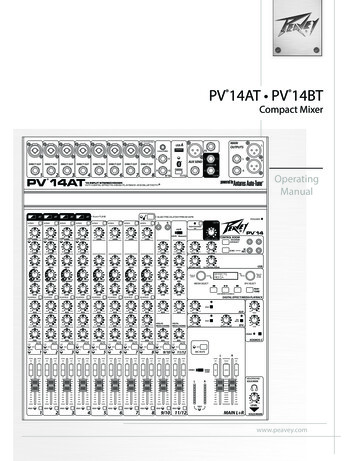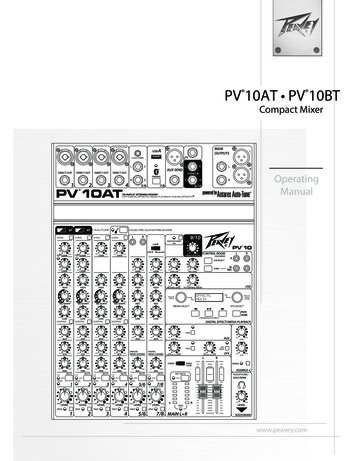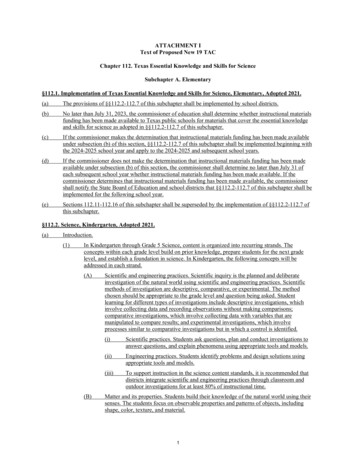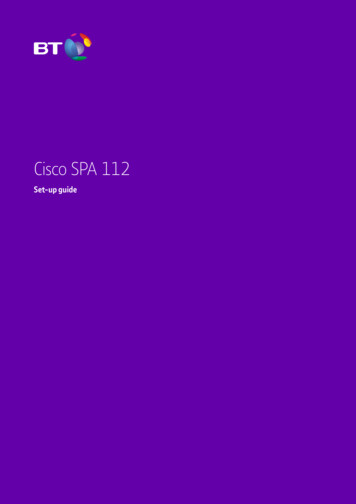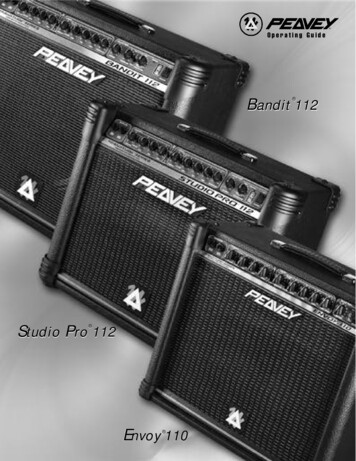
Transcription
Operating Guide Bandit 112 Studio Pro 112Envoy 110
Intended to alert the user to the presence of uninsulated “dangerous voltage” within the product’senclosure that may be of sufficient magnitude to constitute a risk of electric shock to persons.Intended to alert the user of the presence of important operating and maintenance (servicing)instructions in the literature accompanying the product.CAUTION: Risk of electrical shock — DO NOT OPEN!CAUTION: To reduce the risk of electric shock, do not remove cover. No user serviceable parts inside. Referservicing to qualified service personnel.WARNING: To prevent electrical shock or fire hazard, do not expose this appliance to rain or moisture. Beforeusing this appliance, read the operating guide for further warnings.Este símbolo tiene el propósito, de alertar al usuario de la presencia de “(voltaje) peligroso” sin aislamiento dentro de la caja del producto y que puede tener una magnitud suficiente como para constituirriesgo de descarga eléctrica.Este símbolo tiene el propósito de alertar al usario de la presencia de instruccones importantes sobre laoperación y mantenimiento en la información que viene con el producto.PRECAUCION: Riesgo de descarga eléctrica ¡NO ABRIR!PRECAUCION: Para disminuír el riesgo de descarga eléctrica, no abra la cubierta. No hay piezas útiles dentro.Deje todo mantenimiento en manos del personal técnico cualificado.ADVERTENCIA: Para evitar descargas eléctricas o peligro de incendio, no deje expuesto a la lluvia o humedadeste aparato Antes de usar este aparato, Iea más advertencias en la guía de operación.Ce symbole est utilisé dans ce manuel pour indiquer à l’utilisateur la présence d’une tension dangereusepouvant être d’amplitude suffisante pour constituer un risque de choc électrique.Ce symbole est utilisé dans ce manuel pour indiquer à l’utilisateur qu’il ou qu’elle trouvera d’importantesinstructions concernant l’utilisation et l’entretien de l’appareil dans le paragraphe signalé.ATTENTION: Risques de choc électrique — NE PAS OUVRIR!ATTENTION: Afin de réduire le risque de choc électrique, ne pas enlever le couvercle. Il ne se trouve à l’intérieuraucune pièce pouvant être reparée par l’utilisateur. Confiez I’entretien et la réparation de l’appareil à un réparateurPeavey agréé.AVERTISSEMENT: Afin de prévenir les risques de décharge électrique ou de feu, n’exposez pas cet appareil à lapluie ou à l’humidité. Avant d’utiliser cet appareil, lisez attentivement les avertissements supplémentaires de cemanuel.Dieses Symbol soll den Anwender vor unisolierten gefährlichen Spannungen innerhalb des Gehäuseswarnen, die von Ausreichender Stärke sind, um einen elektrischen Schlag verursachen zu können.Dieses Symbol soll den Benutzer auf wichtige Instruktionen in der Bedienungsanleitung aufmerksammachen, die Handhabung und Wartung des Produkts betreffen.VORSICHT: Risiko — Elektrischer Schlag! Nicht öffnen!VORSICHT: Um das Risiko eines elektrischen Schlages zu vermeiden, nicht die Abdeckung enfernen. Es befindensich keine Teile darin, die vom Anwender repariert werden könnten. Reparaturen nur von qualifiziertemFachpersonal durchführen lassen.ACHTUNG: Um einen elektrischen Schlag oder Feuergefahr zu vermeiden, sollte dieses Gerät nicht dem Regenoder Feuchtigkeit ausgesetzt werden. Vor Inbetriebnahme unbedingt die Bedienungsanleitung lesen.2
ENGLISHEnvoy 110, Studio Pro 112 and Bandit 112TransTube Series Instrument AmplifiersCongratulations on your purchase of a Peavey TransTube Series instrument amplifier. Whetheryou are a beginner or seasoned pro, you could not have found a more practical, feature-packedamplifier. Peavey’s patented TransTube circuitry has moved forward into the second generation ofproducts, leading the industry in tube emulation. There is no other solid-state amp that more closelyreplicates the characteristics of a tube amp.Three TransTube Series models are described in this book due to their similarities. These modelsare the Envoy 110, Studio Pro 112 and Bandit 112. Where applicable, the differences in the unitsare noted. The lists below describe the main features and differences between the amps. Pleaseread this manual in its entirety to ensure optimum and safe operation of your new TransTube amp.COMMON FEATURES High and Low Gain Inputs to accommodate a variety of instruments Two distinct TransTube channels each featuring: Separate Volume/Gain controls Low, Mid and High EQ EQ/Gain voicing switches Channel select switch on front panel Spring reverb with reverb level control Remote footswitch capabilityENVOY 110 FEATURES 10" Blue Marvel speaker 40 watt power amplifier Preamp output Headphone jack Footswitchable reverb and channel selectionSTUDIO PRO 112 FEATURES 12" Blue Marvel speaker 65 watt power amplifier Effects send and return T. Dynamics control External speaker jack Footswitchable reverb and channel selectionBANDIT 112 FEATURES 12" Sheffield 1230 speaker 100 watt power amplifier (80 watts into internal speaker) Footswitchable effects loop and channel selection Effects level switch Preamp output Power amp input External speaker jack T-Dynamics control Presence control Resonance switch3
AC POWERIn order to apply power to your TransTube Series amp you must first identify its required AC supplyvoltage. The proper voltage for your unit is labeled on the upper left corner of the rear panel.1.AC Power Cord (Under Chassis)Locate the power cord tucked into the rear speaker compartment. This line cord provides theAC power to the unit. Connect the line cord to a properly grounded AC supply. Damage tothe equipment may occur if improper line voltage is used. (See voltage marking on unit.)Never remove or cut the ground pin of the line cord plug.NOTE: FOR UK ONLYAs the colors of the wires in the mains lead of this apparatus may not correspond with the coloredmarkings identifying the terminals in your plug, proceed as follows: (1) The wire which is coloredgreen and yellow must be connected to the terminal which is marked by the letter E, or by the earthsymbol, or colored green or green and yellow. (2) The wire which is colored blue must be connectedto the terminal which is marked with the letter N, or the color black. (3) The wire which is coloredbrown must be connected to the terminal which is marked with the letter L or color red.2.Power Switch (See Master Section Diagram page 7.)Press this switch to the “ON” position to apply power. The Power LED (3) will illuminate toindicate the unit is on. Pressing the bottom portion of the switch will turn the amp off.3.Power LED (See Master Section Diagram page 7.)This LED will illuminate to indicate the amp is on.TRANSTUBE PREAMPThe TransTube preamp on your amplifier consists of three clearly labeled sections: Inputs, Clean(channel) and Lead (channel). Let’s look at each of these areas individually.54InputsThe inputs of your TransTube Series amplifier are tailored to respond exactly like the inputs foundon popular tube amplifiers. Always use quality, shielded instrument cables when connecting yourinstrument to the input.4.High Gain InputThis is the standard input used for most instrument applications. Most electric guitars willwork ideally when plugged into this 1/4" mono input. The High Gain Input is 6 dB louder thanthe Low Gain Input (5).5.Low Gain InputThis 1/4" mono input is provided for instruments with extremely high outputs, which can resultin overdriving (distorting) the High Gain Input (4). If both the Low Gain and High Gain inputsare used simultaneously, their levels are both Low Gain.4
CHANNELSYour TransTube Series amp offers two-channel operation. Both the Clean and Lead channelsprovide a flexible platform for you to establish your favorite tone. The footswitch (optional on Envoy110 and Studio Pro 112) allows remote switching between the two channels and is explained indetail on page 8 of this guide.66.Channel Select SwitchThe Channel Select Switch determines which channel of the TransTube Preamp, LEAD orCLEAN, is active. This switch must be in the “LEAD” position in order for the footswitchfunction of your amp to work.789CLEAN CHANNEL7.VolumeThis control sets the volume level for the Clean channel. It is best to start with the controlfully counterclockwise (minimum gain) and adjust clockwise until the desired level isachieved. After all EQ and voicing adjustments have been made to the channel, you maywish to reset this control.8.Modern/Vintage SwitchThis switch allows you to instantly change the voicing to reflect the tones of modern andvintage amplifiers. The MODERN position maintains a warm, standard voicing. The VINTAGE5
position changes the overall function of the EQ and adds a hint of brightness to emulatesome classic amp designs. Experiment with this switch, along with Clean EQ (9) adjustments,to capture your desired tone. You may refer to the Recommended Settings on page 11 forsome creative starting points.9.Clean EQThe TransTube EQ featured on the Clean channel of your amp offers 3-band toneadjustment. Each EQ control is passive (does not add gain) and has a frequency rangedependent on the position of the Modern/Vintage Switch. Reducing the control to the “0”position (fully counterclockwise) introduces maximum cut in level for the particular band. Low,Mid and High bands are available for adjustment.10111213LEAD CHANNEL10.Pre GainThe Pre Gain control sets the input level of the Lead channel. Adjusting this control fullyclockwise will result in maximum gain. This control is often used to adjust the amount ofdistortion present in the Lead channel.11.Modern/Vintage/High Gain- SwitchThis switch changes both the gain and voicing of the Lead channel. Selecting theMODERN setting increases the overall gain and notches (cuts) the mid frequencies toestablish a modern tone often associated with Hard Rock and Metal styles. The VINTAGEposition uses the TransTube circuitry to emulate overdriven tube sounds of the past. TheHIGH GAIN setting increases the overall gain and changes the EQ. This creates a tighterresponse at lower Pre Gain settings or an “over the top” sound at higher Pre Gain settings.Experiment with this switch setting while adjusting the Lead EQ (12) to help you obtain yourdesired tone. You may refer to the Recommended Settings on page 11 for some creativestarting points.12.Lead EQThe TransTube EQ featured on the Lead channel of your amp offers 3-band tone adjustment.Each EQ control is passive (does not add gain) and has a frequency range dependent on theposition of the Modern/Vintage/High Gain Switch. Reducing the control to the “0” position(fully counterclockwise) introduces maximum cut in level for the particular band. Low, Mid andHigh bands are available for adjustment.6
13.Post GainUse this control to set the overall level of the Lead channel once your tone has beenachieved. It is best to start with the control fully counterclockwise (minimum gain) and adjustclockwise until the desired level is achieved. After all EQ and voicing adjustments have beenmade to the channel, you may wish to reset this control.MASTER SECTIONThe Master sections of the TransTube Series amps vary from unit to unit. Please read carefully.Each feature’s description identifies its applicable model(s).Envoy 110143Studio Pro 11221415Bandit 11232141617153214.ReverbThe Reverb control adjusts the overall reverb level. This control is found on all three models.Note: Reverb can be defeated by the Remote Switch (18) on the Envoy 110 and StudioPro 112 models.15.T-Dynamics This control adjusts the power level of the amplifier from 10 percent to 100 percent power.When set to lower settings, the power compression simulation will be much morepronounced. This control is found on the Studio Pro 112 and Bandit 112.16.PresenceThis active tone control boosts the extreme high frequencies by as much as 6 dB. Thiscontrol is found on Bandit 112 only.17.ResonanceUse this switch to set the low frequency resonance of the speaker enclosure by varying thedamping factor of the amplifier between two settings, TIGHT and LOOSE. In the TIGHTposition, the amlifier has a higher damping factor causing the speaker/cabinet combination toresonate less.The LOOSE position allows the characteristics of the poweramp/cabinet/speaker combination to resonate more at low frequencies. Thus, the resonantfrequency of the cabinet is used to produce more low end, simulating a larger cabinet. Thiscontrol is found on the Bandit 112 only.7
REAR PANELThe rear panel features of the TransTube Series amps vary from unit to unit. Please read eachcarefully. Each feature’s description identifies its applicable model(s).19118211201822251212324201818.Remote SwitchThis jack accepts the appropriate remote footswitch for your amp. The footswitch (optional onEnvoy 110 and Studio Pro 112) is a multi-function type. It is used to select between the Cleanand Lead channels. Additionally, the footswitch is used to activate/deactivate the Reverb onthe Envoy 110 and Studio Pro 112 models. On the Bandit, the footswitch (included) provideschannel selection and Effects Loop (20) defeat. The Channel Select Switch (6) must be in theLEAD position for the Remote Switch to work.19.Headphones JackThis stereo 1/4" jack accepts a standard pair of headphones. Using this jack defeats theoutput to the speaker making it ideal for quiet practice applications. This jack is featured onthe Envoy 110 only.NOTE: The remaining features apply to the Studio Pro 112 and/or the Bandit 112 models only.20.Effects LoopThis pair of mono 1/4" jacks supply an effects SEND and RETURN path for the preampsignal. Connect the SEND jack to the input of external, low-level, signal processingequipment (effects). Return the signal from your external equipment to the RETURN jack.This is known as an Effects Loop since the signal exits your amp (send) and loops (return)back to it. On the Bandit 112, the effects loop can be swapped in and out of the signal pathusing the supplied Remote Switch (18).8
21.External Speaker JackThis 1/4" jack is provided for the connection of an external speaker cabinet such as thePeavey 412M. The minimum external speaker impedance is 8 ohms. This jack disconnectsinternal speaker when used on Studio Pro 112NOTE: The remaining features apply to the Bandit 112 model only.22.Preamp OutThe Preamp Output can be used to route the preamp signal to a mixing console, taperecorder, etc. Using a shielded instrument cable with mono 1/4" plugs, connect the PreampOutput to the input of your outboard equipment. This patch will not affect the normal operationof your amplifier.23.Power Amp InConnect line level signals from external equipment to this input. Inserting a plug into thismono 1/4" jack will prevent the TransTube preamp signal from being sent to the amplifier.In this configuration, the power amp only amplifies the signal introduced at the Power AmpIn jack.24.Effects LevelThis switch selects the Effects Loop (20) operating level. When the switch is pressed to the“in” position the level is set for 0 dBV (1 V RMS). Placing the switch to the “out” positionchanges the level to -10 dBV (0.3 V RMS). Refer to the owner’s manual for your externaleffects to determine the correct position for this switch.2525.Ground SwitchPlace this switch in the center position (0) during normal operation. If audible hum occurs,position the ground switch in either the positive ( ) or negative (-) position to minimize thenoise. You may have to try both positions to see which is more quiet.NOTE: Should the noise problem continue, consult an Authorized Peavey Dealer or PeaveyRepair Center. THE GROUND SWITCH IS NOT FUNCTIONAL ON 220/240 VOLT MODELS.9
GEMODERNSWITCHLOGICVOLUMELO MID HIHIGAINEQUALIZATIONLO MID HIVINTAGE MODERNPRELEADPOSTFOOTSWITCHFOOTSWITCHLEVELREVERB D RETURNPOWERAMPEFFECTSSEND RETURN STUDIOSTUDIOPROPRO112LEVELREVERBBANDIT BANDIT 112T. DYNAMICSPOWERAMPPRE PWROUT 2"SPEAKERT. DYNAMICSRESONANCEEnvoy 110, Studio Pro 112 and Bandit 112,Level DiagramEXT.SPEAKER12"SPEAKER
RECOMMENDED SETTINGSCleanMetalYour PreferenceYourPreferenceJazzModerate DistortionYour PreferenceYourPreferenceClean BluesDirty Blues**Your PreferenceNOTE: The Bandit 112 is used for demonstration purposes. The settings illustrated above are alsoapplicable to the Envoy 110 and Studio Pro 112, with the exception of the resonance and presencecontrols.11
ENVOY 110SPECIFICATIONSPOWER AMPLIFIER SECTION:Power @ Clipping: (Typically)Preamp Low Gain Input:Impedance: High Z, 44k OhmsNominal Input Level: -7dBV, 450mV RMSMinimum Input Level: -16dBV, 164mV RMSMaximum Input Level: 6dBV, 2V RMS(5% THD, 1 kHz, 120V AC line)40W RMS into 6 OhmsFrequency Response:Headphone Output: 0, -2 dB 100 Hz to 20 kHz @ 35W RMSinto 6 OhmsLoad Impedance: 16 Ohms or greaterNominal Output Level: -3 dBV, 0.7V RMSHum and Noise:System Hum and Noise @ Nominal Input Level:Greater than -86 dB below rated power(20 Hz to 20 kHz unweighted)Greater than 78 dB below rated powerPower Consumption:75W @ 60 Hz, 120V AC, Domestic75W @ 50/60 Hz, 220-230/240V AC, ExportEqualization:Special Low, Mid, and High passive type EQ.Modern/Vintage switch (Clean):Two distinct EQ voicings.Vintage/Modern/High Gain switch (Lead):Three different EQ and Gain voicingsPREAMP SECTION:The following specs are measured @ 1 kHz with thecontrols preset as follows:Channel Select, CleanClean Mode Switch, ModernLow and High @ 10Mid @ 0Lead Pre and Post Gain @ 10Lead Mode Switch, VintageReverb @ 0Nominal Levels are with Clean Volume @ 5Minimum Levels are with Clean Volume @ 10External Footswitch Functions:Select: Clean or Lead channel selection.Reverb: Reverb bypassDimensions (H x W x D):16” H x 18.13” W x 9.5” D40.1cm x 46.1cm x 24.1cmWeight:Preamp High Gain Input:21.7 lbs. (9.84 kg)Impedance: High Z, 250 K OhmsNominal Input Level: -13 dBV, 225mV RMSMinimum Input Level: -22 dBV, 82mV RMSMaximum Input Level: 0 dBV, 1V RMSSpecifications subject to change without notice.12
STUDIO PRO 112SPECIFICATIONSPOWER AMPLIFIER SECTION:Preamp Low Gain Input:Rated Power and Load:Power specs measured with T-Dynamics @ 100%65W RMS into 8 OhmsImpedance: High Z, 44 k OhmsNominal Input Level: -6 dBV, 500mV RMSMinimum Input Level: -17dBV, 142mV RMSMaximum Input Level: 6 dBV, 2V RMSPower @ Clipping: (Typically)(5% THD, 1 kHz, 120V AC line)65W RMS into 8 OhmsEffects Send:Load Impedance: 1k Ohms or greaterNominal Output Level:Effects Level -9dBV, 355 mV RMSFrequency Response: 3, -0 dB 100 Hz to 20 kHz @ 45W RMS into8 OhmsHum and Noise:Greater than 88 dB below rated powerPower Consumption:200W @ 60 Hz, 120V AC, Domestic200W @ 50/60 Hz, 220-230/240V AC, ExportPREAMP SECTION:The following specs are measured @ 1 kHz with thecontrols preset as follows:Channel Select, CleanClean Mode Switch, ModernLow and High @ 10Mid @ 0Lead Pre and Post Gain @ 10Lead Mode Switch, VintageReverb @ 0Nominal Levels are with Clean Volume @ 5Minimum Levels are with Clean Volume @ 10Preamp High Gain Input:Impedance: High Z, 250 K OhmsNominal Input Level: -12 dBV, 250mV RMSMinimum Input Level: -23 dBV, 71mV RMSMaximum Input Level: 0 dBV, 1V RMSEffects Return:Impedance: High Z, 22k OhmsDesigned Input Level:Effects Level -9dBV, 355 mV RMS(Switching jack provides Effects Send to EffectsReturn connection when not used.)System Hum and Noise @ Nominal Input Level:(20Hz to 20kHz unweighted)Greater than 74dB below rated powerEqualization:Special Low, Mid, and High passive type EQModern/Vintage switch (Clean): Two distinctEQ voicingsVintage/Modern/High Gain switch (Lead):Three different EQ and Gain voicingsExternal Footswitch Functions:Select: Clean or Lead channel selectionReverb: Reverb bypassDimensions (H x W x D):18” x 21.5” x 10.5”45.7cm x 54.6cm x 26.7cmWeight:34.1 lbs. (15.47kg)Specifications subject to change without notice.13
BANDIT 112SPECIFICATIONSPOWER AMPLIFIER SECTION:Rated Power and Load:Effects Send:Load Impedance: 1 k Ohms or greaterNominal Output Level:Effects Level switch “out”: -10 dBV,0.32V RMSEffects Level switch “in”: 0 dBV, 1V RMSPower specs measured with T-Dynamics @ 100%80W RMS into 8 Ohms100W RMS into 4 OhmsPower @ Clipping: (Typically)Effects Return:(5% THD, 1 kHz, 120V AC line)80W RMS into 8 Ohms100W RMS into 4 OhmsImpedance: High Z, 22k OhmsDesigned Input Level:Effects Level switch “out”: -10 dBV,0.32V RMSEffects Level switch “in”: 0dBV, 1V RMS(Switching jack provides Effects Send to EffectsReturn connection when not used.)Frequency Response: 0, -3 dB 100 Hz to 20 kHz @ 65W RMSinto 8 OhmsHum and Noise:Preamp Output:Greater than 88 dB below rated powerLoad Impedance: 1 k Ohms or greaterNominal Output Level: 0 dBV, 1V RMSPower Consumption:300W @ 60 Hz, 120V AC, Domestic300W @ 50/60 Hz, 220-230/240V AC, ExportPower Amp Input:Impedance: High Z, 22k OhmsDesigned Input Level: 0 dBV, 1V RMS(Switching jack provides preamp output to poweramp input connection when not used.)PREAMP SECTION:The following specs are measured @ 1 kHz with thecontrols preset as follows:Channel Select, CleanClean Mode Switch, ModernLow and High @ 10Mid @ 0Lead Pre and Post Gain @ 10Lead Mode Switch, VintageReverb @ 0Nominal Levels are with Clean Volume @ 5Minimum Levels are with Clean Volume @ 10System Hum and Noise @ Nominal Input Level:(20 Hz to 20 kHz unweighted)Greater than 78 dB below rated powerEqualization:Special Low, Mid, and High passive type EQModern/Vintage switch (Clean): Two distinctEQ voicingsVintage/Modern/High Gain switch (Lead):Three different EQ and Gain voicingsPresence: 6 dB @ 5 kHzPush Resonance: 6 dB @ resonantfrequency of cabinetPreamp High Gain Input:Impedance: High Z, 250 K OhmsNominal Input Level: -14 dBV, 185mV RMSMinimum Input Level: -23 dBV, 66mV RMSMaximum Input Level: 0 dBV, 1V RMSExternal Footswitch Functions:Select: Clean or Lead channel selectionEffects: Effects loop bypassPreamp Low Gain Input:Impedance: High Z, 44 k OhmsNominal Input Level: -8 dBV, 380 mV RMSMinimum Input Level: -17 dBV, 136 mV RMSMaximum Input Level: 6 dBV, 2 V RMSDimensions (H x W x D):19.75" x 23.63" x 11.5"50.16cm x 60.02cm x 29.2cmWeight:43.9lbs. (19.91kg)Specifications subject to change without notice.14
ESPAÑOLEnvoy 110, Studio Pro 112 y Bandit 112de la Serie Transtube deAmplificadores para InstrumentosFelicitaciones por la compra de un amplificador para instrumento de la serie Transtube de Peavey.Seas un principiante o un profesional consagrado, no podrías haber encontrado un amplificadormás práctico y con mejores características. Los circuitos patentados Transtube de Peavey hanavanzado a la segunda generación de productos, siendo los primeros en la industria en emulaciónde bulbos. No hay otro amplificador de estado sólido que replique de manera más precisa lascaracterísticas de un amplificador de bulbos.Tres modelos de la Serie Transtube son descritos en este libro debido a sus similitudes. Estosmodelos son el Envoy 110, StudioPro 112 y Bandit 112. En los lugares apropiados, las diferenciasentre las unidades son marcadas. Las listas que siguen describen las características principales ylas diferencias entre los amplis. Por favor lee este manual completamente para asegurar unaóptima y segura operación de tu nuevo ampli Transtube.CARACTERÍSTICAS COMUNES Entradas de ganancia alta y baja para acomodar una variedad de instrumentos Dos canales Transtube distintivos que presentan: Controles separados de volumen/ganancia Ecualizador de graves, medios y agudos Switches de ecualización/voces de ganancia Switch de selección de canal en el panel frontal Reverb de resorte con control de nivel de reverb Capacidad de uso de pedal remotoCARACTERÍSTICAS DEL ENVOY 110 Bocina Blue Marvel de 10" Amplificador de poder de 40 Wats Salida de preamplificador Entrada para audífonos Selección de reverb y canal por medio de pedalCARACTERÍSTICS DEL STUDIO PRO 112 Bocina Blue Marvel de 12" Amplificador de poder de 65 Wats Envío y retorno para efectos Control de T-Dynamics Conexión para bocinas externas Selección de reverb y canal por medio de pedalCARACTERÍSTICAS DEL BANDIT 112 Bocina Sheffield 1230 de 12" Amplificador de poder de 100 Wats (80 Wats hacia la bocina interna) Selección de Circuito de efectos y canal por medio de pedal Switch de nivel de efectos15
Salida de preamplificadorEntrada para amplificador de poderConexión para bocinas externasControl T-Dynamics Control de presenciaPODER DE CORRIENTE ALTERNAPara poder aplicar poder a tu amplificador de la Serie Transtube, primero debes identificar susuministro de voltaje de CA. El voltaje apropiado para tu unidad está rotulado en la esquina superiorizquierda del panel trasero.1.Cable de Poder de CA (Debajo del Chasis)Localiza el cable de poder que está guardado en el compartimento de bocina trasero. Estecable suministra el poder de CA a la unidad. Conecta el cable a un suministro de CApropiamente aterrizado. El equipo puede ser dañado si se usa un voltaje de línea incorrecto(ver marcación de voltaje en la unidad). Nunca quites o cortes la aguja de tierra del conectordel cable.2.Switch de Poder (Ver diagrama de la Sección Maestra en la página 7)Oprime el switch a la posición "ON" para aplicar poder. El LED de poder (3) se iluminará paraindicar que la unidad está encendida. El oprimir la porción inferior del switch apagará elamplificador.3.LED de Poder (ver diagrama de la Sección Maestra en la página 7)LED se iluminará para indicar que el ampli está encendido.PREAMPLIFICADOR TRANSTUBEEl preamplificador Transtube de tu amplificador consiste de tres secciones claramente rotuladas:Inputs, Clean (limpio) y Lead. Veamos cada una de estas áreas individualmente.54EntradasLas entradas de tu amplificador de la Serie Transtube están diseñadas para responder exactamentecomo las entradas de los amplificadores de bulbos populares. Siempre usa cables protegidos decalidad cuando conectes tu instrumento a la entrada.4.Entrada de Alta GananciaÉsta es la entrada estándar usada para la mayoría de las aplicaciones con instrumento. Lamayoría de las guitarras eléctricas funcionarán de manera óptima al conectarlas a estaentrada monofónica de un 1/4". La entrada de alta ganancia es 6 dB más fuerte que laentrada de baja ganancia (5).16
5.Entrada de Baja GananciaEsta entrada monofónica de 1/4" se incluye para instrumentos con salidas extremadamentealtas, lo que puede resultar en una distorsión de la entrada de alta ganancia (4). Si se usansimultáneamente las entradas de alta y baja ganancia, los niveles de ambas son de bajaganancia.CANALTu ampli de la Serie Transtube ofrece operación a dos canales. Tanto el canal ‘clean’ como el ‘lead’proveen una plataforma flexible para que establezcas tu tono favorito. El pedal (opcional en elEnvoy 110 y Studio Pro 112) te permite controlar los dos canales de manera remota y es explicadoen detalle en la página 8 de esta guía.66.Switch de Selección de CanalEl switch de Selección de Canal determina qué canal del preampli Transtube, LEAD oCLEAN, está activo. Este switch debe estar en la posición “LEAD” para que la función delpedal de tu ampli funcione.789CANAL LIMPIO (CLEAN)7.VolumenEste control ajusta el nivel de volumen para el canal limpio. Lo más recomendable esempezar con el control girado totalmente hacia la izquierda (ganancia mínima) y ajustarlo17
hacia la derecha hasta lograr el nivel deseado. Después de hacer todos los ajustes deecualización y voces en el canal, tal vez querrás reajustar este control.8.Switch Modern/VintageEste switch te permite cambiar instantáneamente el tono para emular amplificadoresmodernos y clásicos. La posición MODERN mantiene un tono cálido y estándar. La posiciónVINTAGE cambia la función general de la ecualización añadiendo algo de brillo y emulandoalgunos diseños de amplis clásicos. Experimenta con este switch, junto con ajustes deecualización limpia (9), para capturar tu tono deseado. Puedes referirte a los AjustesRecomendados de la página 11 para obtener algunos puntos de partida creativos.9.Ecualización LimpiaEl ecualizador Transtube en el canal limpio de tu ampli ofrece ajuste de tono a tres bandas.Cada control de ecualización es pasivo (no ofrece ganancia) y tiene un rango de frecuenciaque depende de la posición del switch Modern/Vintage. Si reduces el control a la posición “0”(totalmente hacia la izquierda) introducirás el máximo corte de nivel para esa banda enparticular. Están disponibles bandas para ajuste de graves, medios y agudos.10111213CANAL LÍDER10.Pre GananciaEl control de Pre Ganancia controla el nivel de entrada del canal líder. Ajustar este controltotalmente hacia la derecha resultará en una máxima ganancia. Este control es usadocomúnmente para ajustar la cantidad de distorsión presente en el canal líder.11.Switch Modern/Vintage/High GainEste switch cambia tanto la ganancia como el tono del canal líder. Si lo ajustas a MODERN,se incrementa la ganancia general y se cortan las frecuencias medias para establecer untono moderno comúnmente asociado con los estilos Hard Rock y Metal. La posiciónVINTAGE usa los circuitos Transtube para emular los sonidos distorsionados creados conbulbos en épocas pasadas. La posición HIGH GAIN incrementa la ganancia general ycambia la ecualización. Esto crea una respuesta más “apretada” en las posiciones más bajasde preganancia, o un sonido exagerado en las posiciones más altas de preganancia.Experimenta con los ajustes de este switch y usa el ecualizador líder (12) al mismo tiempopara ayudarte a obtener el tono deseado. Puedes referirte a los Ajustes Recomendados de lapágina 11 para obtener algunos puntos de partida creativos.12.Ecualizador LíderEl ecualizador Transtube en el canal líder de tu ampli ofrece ajuste de tono a tres bandas.Cada control de ecualización es pasivo (no ofrece ganancia) y tiene un rango de frecuencia18
que depende de la posición
LEAD CHANNEL 10. Pre Gain The Pre Gain control sets the input level of the Lead channel. Adjusting this control fully clockwise will result in maximum gain. This control is often used to adjust the amount of distortion present in the Lead channel. 11. Modern/Vintage/High Gain- Switch This switch changes both the gain and voicing of the Lead .

